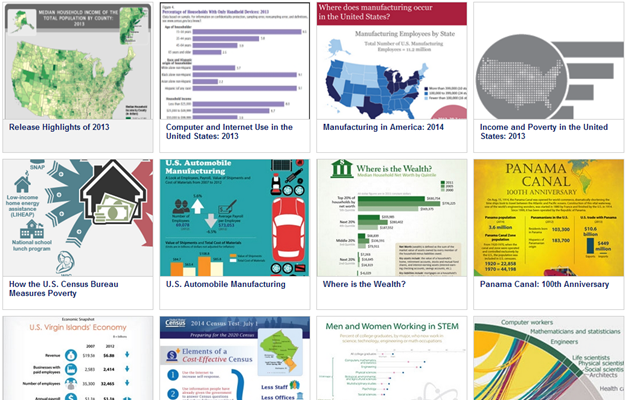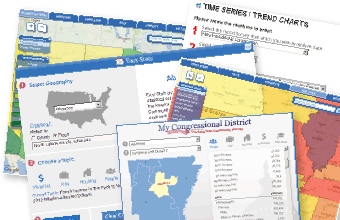Tip Sheet Number 2 — January 24, 2025
Upcoming
2025 Product Calendar
The U.S. Census Bureau has posted anticipated release dates for each regular and recurring statistical product scheduled for release in 2025. These products are listed in the Census Bureau’s online product calendar, which is updated as needed throughout the year.
Webinar on New Disclosure Avoidance Principles
Join us for a webinar covering our new framework for evaluating the strengths and limitations of different applied disclosure avoidance systems. Visit the Disclosure Avoidance Webinar Series page for recordings, transcripts and slides for all disclosure avoidance webinars. (Scheduled for Jan. 28.)
Census Bureau Releases 2023 Community Resilience Estimates and Natural Hazard Risk Ranking Tables
The U.S. Census Bureau is scheduled to release the 2023 Community Resilience Estimates, which highlight socially vulnerable areas in the United States. Featuring a new interactive tool, this release includes seven ranking tables per geographic level, highlighting the nation’s most socially vulnerable counties (top 25) and census tracts (top 100) in the following context: winter weather risk areas (i.e., snow, sleet and freezing rain); flooding risk areas (i.e., coastal flooding and riverine flooding); hurricane risk areas; strong wind risk areas (i.e., damaging winds exceeding 58 mph); wildfire risk areas; and earthquake risk areas (new for 2023 CRE). (Scheduled for release Jan. 30.)
Demographic
Household Pulse Survey
The experimental Household Pulse Survey (HPS) is an effort by the Census Bureau and other federal statistical agencies to measure how emergent issues are impacting U.S. households from a social and economic perspective.
The Census Bureau has changed the HPS to enhance efficiency and representativeness of the data. Since early October 2024, HPS content has been incorporated into a longitudinal design, with data collection occurring bi-monthly. The longitudinal design will benefit HPS data by allowing direct measurement of change over a longer period in critical elements like spending, inflation, and other social and economic indicators of well-being. The October public-use file was released Dec. 18, 2024; the December 2024 public-use file will be released Feb. 5, 2025. With the change to a longitudinal design, the sample size is smaller and data will be released at a national level.
To acknowledge these design changes, the Census Bureau rebranded the HPS as the Household Trends and Outlook Pulse Survey (HTOPS) in January 2025. For more information on these changes, visit Evolving the Household Pulse Survey.
Economic
"Exploring the Enhanced Veteran Employment Outcomes Data Tool"
The U.S. Census Bureau and the Local Employment Dynamics (LED) Partnership in collaboration with the Council for Community and Economic Research (C2ER) and the Labor Market Information (LMI) Institute, welcomes David Wasser as he presents, “Exploring the Enhanced Veteran Employment Outcomes Data Tool.” Recently the U.S. Census Bureau released an expanded version of Veteran Employment Outcomes (VEO). The updated experimental data product now includes earnings and employment outcomes for veterans honorably discharged between 2002 and 2021 as well as from additional branches of the Armed Services. These data show import ant differences across military rank and occupation, regardless of the branch of service. The Census Bureau partnered with the Department of Defense to update and expand VEO. Earnings and employment outcomes of more than 2.8 million enlisted service members are now available. (Scheduled for Feb. 19.)
2025 Local Employment Dynamics (LED) Partnership Workshop (Save the Date: April 8-10)
Join us for our 2025 Local Employment Dynamics (LED) Partnership Workshop, featuring keynote speaker Ellen Zentner, chief economic strategist and global head of Thematic and Macro Investing at Morgan Stanley. We are expanding our topics to include discussions on our newer products. Mark your calendar for an exciting event! Further details and an agenda, when available, will be posted on the LEHD website. We are welcoming proposals to present at the workshop - the deadline to submit proposals is Tuesday, February 18, 2025. Please see this document for additional proposal guidelines. Information on previous workshops can also be found at Workshops and Webinars - Longitudinal Employer-Household Dynamics. If you have any questions about the workshop, please email [email protected].
Business Trends and Outlook Survey (BTOS)
The BTOS measures business conditions on an ongoing basis. The BTOS experimental data products are representative of all employer businesses in the U.S. economy, excluding farms. The data allow greater insight into the state of the economy by providing continuous, timely information for key economic measures. Data are released biweekly and are available by sector, state, employment size and the 25 most populous metropolitan statistical areas.
Monthly Business Formation Statistics
Business Formation Statistics (BFS) provide timely, high-frequency data on business applications and employer business formations monthly. The data are available at the state, regional and national levels, and by industry sector at the national level. The next monthly BFS will be released Feb. 12 and will include January 2025 data. Business Formation Statistics - Release Schedule (census.gov).
Recently Released
(Released since Jan. 10, 2025)
2030 Census
Census Bureau Virtual Tribal Consultation on Race/Ethnicity Coding Improvement Project — Jan. 15
The U.S. Census Bureau hosted a virtual webinar with federally recognized tribes and state-recognized tribes on the Race/Ethnicity Coding Improvement Project. Tribes were given an opportunity to provide feedback on how detailed race/ethnicity populations and American Indian and Alaska Native tribes and villages will be coded in the American Community Survey (ACS) and 2030 Census. The recording, transcript and more information on the consultation is available on the Census Bureau Tribal Consultation page.
Economic
2022 Nonemployer Statistics of the U.S. Marine Economy — Jan. 21
The U.S. Census Bureau released the 2022 Nonemployer Statistics (NES) estimates of the U.S. Marine Economy. Nonemployer Statistics provide economic data for businesses that have no paid employees, are subject to federal income tax, and have receipts of $1,000 or more ($1 or more for the Construction sector). Nonemployer establishment counts and receipts estimates are provided by non-standard state- and county-equivalent geographies comprised of selected coastal regions across each state, and by the Economics: National Oceanic Watch (ENOW) sectors, defined by the Office for Coastal Management at the National Oceanic and Atmospheric Administration (NOAA). The ENOW sectors include tourism and recreation, ship and boat building, marine construction and transportation, offshore minerals, and living resources such as fishing.
Veteran Employment Outcomes Update — Jan. 14
The U.S. Census Bureau released an expanded version of Veteran Employment Outcomes (VEO). The updated experimental data product now includes earnings and employment outcomes for veterans honorably discharged between 2002 and 2021 as well as from additional branches of the Armed Services. These data show important differences across military rank and occupation, regardless of the branch of service. The Census Bureau partnered with the Department of Defense to update and expand VEO. Earnings and employment outcomes of more than 2.8 million enlisted service members are now available.
New Post-Secondary Employment Outcomes Data — Jan. 10
The U.S. Census Bureau released new PSEO tabulations showing earnings and employment outcomes of graduates of U.S. post-secondary institutions. The stats are generated by linking graduate transcript records to Longitudinal Employer-Household Dynamics wage data. This offers prospective students a comprehensive assessment tool to find out how much they could potentially earn by degree and institution. The Census Bureau conducts the PSEO in cooperation with higher education institutional systems to examine college degree attainment and graduate earnings.
Facts for Features
National Black (or African American) History Month: February 2025 — Dec. 11
To commemorate and celebrate the contributions to our nation made by people of African descent, the U.S. Census Bureau presents a collection of demographic and economic statistics about the Black community.
America Counts: Stories Behind the Numbers
America Counts tells the stories behind the numbers in a new and inviting way. We feature stories on various topics such as families, housing, employment, business, education, the economy, emergency preparedness and the population. New stories include:
Stats for Stories
Stats for Stories provides links to timely story ideas highlighting the Census Bureau’s newsworthy statistics that relate to current events, observances, holidays and anniversaries. The story ideas are intended to assist the media in story mining and producing content for their respective audiences.
Blogs
AIAN Groups Will Provide Input on Improving Their Data — Jan. 13
Written by: Robert L. Santos, Director — Indigenous people have lived on the land we now call North America for millennia. They thrived on this land establishing structured governments, treaties and alliances still relevant today. They have preserved their culture, language and governance structure while continuing to lead with dignity and resilience.
Resources
Emergency Management/Disaster Resources
When major disasters strike, visit our Emergency Management webpage for demographic and economic data on impacted areas. Each disaster will include data from our key emergency management tools: OnTheMap for Emergency Management, Community Resilience Estimates, Census Business Builder: Regional Analyst Edition, and other useful resources.
Learn What Surveys Are Being Conducted in Your Community
Discover which of the U.S. Census Bureau’s 130-plus annual surveys are being conducted in your community. In a variety of surveys and censuses, evolving from the first census in 1790, the Census Bureau provides official information about America’s people, businesses, industries and institutions. Learn more about surveys currently being conducted in each Census Bureau region:
Data Tools
Below are a few of the U.S. Census Bureau’s interactive applications used to access statistics from our 130-plus annual surveys. A complete list can be accessed on the Census Bureau’s Data Tools and Apps webpage.
FRED® Economic Data
The U.S Census Bureau’s publicly available data sets and tools to assist in the equitable distribution of resources, and identifying underserved communities.
Job-to-Job Flows Explorer
Analyze the Job-to-Job Flows (J2J) data through interactive charts, maps and tables.
PSEO Explorer
Visualize the experimental Post-Secondary Employment Outcomes (PSEO) data through interactive bar charts and Sankey diagrams.
Training Opportunities
Census Bureau Training Opportunities
Webinars are available on a regular basis to help the public access and use Census Bureau statistics. These free sessions, which are 60 to 90 minutes each, show users how to navigate Census Bureau databases and mapping tools and find demographic and economic statistics at the local or national level. Descriptions of upcoming sessions are available on our Census Academy webpage. Login details are provided at least one week before a webinar.
- Towards a Principled Framework for Disclosure Avoidance (Tuesday, Jan. 28, 3-4 p.m. ET)
- Salario mínimo e inequidad de ingresos en Puerto Rico (Thursday, Jan. 30, 10-11:30 a.m. ET)
- Measuring Poverty Using Census Bureau Data (Thursday, Jan. 30, 2-3 p.m. ET)
- Exploring the Enhanced Veteran Employment Outcomes Data Tool (Wednesday, Feb. 19, 1:30-2:45 p.m. ET)
- Discovering the American Community Survey 1-Year Supplemental Estimates (Wednesday, Feb. 26, 2-3 p.m. ET)
Archived Training Resources — Visit the Census Bureau’s Educational Resource Library for previously recorded, free training available at your convenience. The library includes presentations, recorded webinars, tutorials and other helpful materials.





